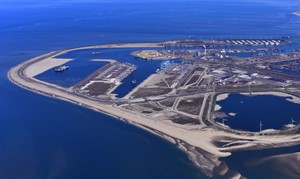News
Port of Rotterdam Authority offers site for 1-GW capacity green H2 plant
The Port of Rotterdam Authority is developing an 11ha site on the Maasvlakte suitable for the construction of a very large green H2 plant. The reason is the tender for the IJmuiden Ver Wind Farm later this year.
In the procedure for plot Beta, the Minister for Climate and Energy is encouraging companies to smartly integrate much of the wind energy into the energy system. The production of H2 directly on the coast is a logical solution, as it avoids additional load on the high-voltage network. The wind farm and H2 plant should be ready around 2028.
Allard Castelein, Port of Rotterdam Authority CEO said, “The construction of a H2 plant with a capacity of 1 GW is the next leap in scale in the production of green H2. Several companies are now building, or have advanced plans to build, electrolyzers with a capacity of 200 MW to 250 MW at the Maasvlakte. These would currently be the largest in Europe, but we already want to accommodate the next generation of H2 plants. These are expected to be five times larger.”
Several companies have plans to realize a total of some 1,350 MW (1.35 GW) of electrolysis in Rotterdam. The ambition of the Port Authority is to achieve 2 GW to 2.5 GW of electrolysis by 2030. That will be within reach with this development. The national government is aiming for 4 GW nationwide by 2030.
More and more wind farms will be built in the North Sea in the coming years. Part of the electricity they generate will be used to make green H2: electrolysis allows water to be split into H2 and oxygen. This green H2 is an alternative to natural gas. Making H2 directly on the coast is appealing, since it does not require additional high-voltage cables on land. It is also attractive to produce where the main customers are: industry.
In late March, the Minister for Climate and Energy announced the draft ministerial regulations for IJmuiden Ver Wind Farm Zone Beta. It will have a capacity of 2 GW and should be ready around 2028. The formal tender process will start in the second half of 2023. Various parties have already indicated their interest. The Port of Rotterdam Authority will reserve 11 hectares on the Maasvlakte exclusively for the party that wins this tender and wants to produce green H2 on a large scale in Rotterdam.
This site offers space for up to 1 GW of electrolysis and is located next to where Tennet’s Amaliahaven (380 kV) high-voltage substation will be built. This is the destination of the 2 GW DC cable from the IJmuiden Ver Wind Farm Zone Beta. All green electricity converted directly into H2 does not enter the electricity grid, thus avoiding additional load on the grid. In addition, the new H2 pipeline will soon run alongside the site. The H2 produced here can thus be efficiently transported to customers. Moreover, the site is close to the Evides water pipeline. Finally, the Port Authority is exploring the possibility of connecting the Maasvlakte H2 plants to regional heat networks. This will eventually allow them to use green heat to heat houses, greenhouses and offices. All these factors make this a very strategic location to produce green H2.
The Ministry of Economic Affairs promotes different aspects in different tender procedures for wind farms. At IJmuiden Ver Zone Alpha, which lands in Borsele, the emphasis is on nature development in conjunction with the wind farms, at Zone Beta on so-called system integration. This means assessing how a plan fits into the overall Dutch energy system. Using green electricity to produce green H2 is therefore the obvious choice. To allocate the site for H2 production, the Port Authority is consulting with the municipality and DCMR on amending the zoning plan: the site is currently zoned for container storage.


